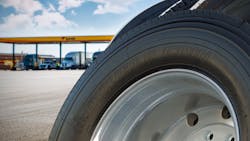Heavy-duty equipment trends of 2023: Tire outlook
This is Part 3 of a 3-part series on heavy-duty equipment trends. Read Part 1 here. Read Part 2 here.
Tires rank at the very top of fleets' list when it comes to most frequently replaced items and biggest expenses. And recently, they have likely caused the biggest headaches. Each of the five tire OEs we contacted said that the pandemic disrupted production, making them harder to acquire, and their costs increased. That should come as no surprise, as inflation has done that to just about everything.
And unlike in the truck and trailer sectors, there are still tire manufacturers reporting delays, some of which have affected deliveries to customers. But tire OEs on the whole are ready to bounce back in 2023.
“The tire industry seems to be in a state of flux,” said Tommy Bazzell, director of national accounts, truck stop and trailer OEM sales at Yokohama Tire.
He mentioned that technology, operational changes, and the growth of particular segments, such as last mile, all force the tire industry to constantly evolve and improve. Because the industry is so used to change, Bazzell said it was able to “rise to meet the challenges” of the past few years.
Yokohama Tire specifically was incredibly productive, releasing 12 new tire products during the pandemic and expanding the company’s Mississippi manufacturing plant.
Because of the recent spate of shortages, Bazzell advised that fleets focus on ensuring longer tire life.
“This involves making sure the tire used is designed for the application of the fleet,” he said. “It could also involve technologies and/or manual-based best practices to ensure proper psi and any data-driven technologies that will extend the life of a tire. These measures will also increase uptime, optimize fuel economy, enhance safety, and lower total cost of ownership.”
Another way to boost TCO is via digital monitoring.
“This real-time solution reduces downtime related to tires, increases labor productivity, keeps fleets operating safely, and allows fleets to save money by reducing non-retreadable tires and roadside emergencies,” explained Brian Cunningham, VP of fleet solutions at Bridgestone Americas. He noted that Bridgestone’s Last Mile Tire System allows small and midsized fleets to better mange their tire programs. The pay-as-you-go program monitors tires to optimize tire pull points and notifies servicers when low-tread depth is detected.
Aaron Murphy, SVP at Double Coin, agreed that fleets will have to focus on performance and retreadability, as well as lowering overall cost per mile, to stay profitable as freight volumes drop.
“If we move further into an economic downturn, these items assist a fleet in reducing their operating costs,” he said. “The lowest price is not always the answer to driving down maintenance costs.”
Fleets can’t do this alone.
“With fleets utilizing equipment for longer periods of time and with more frequency, service partners are key,” Murphy said. “Whether that’s the manufacturer or dealer, this relationship can improve total cost of ownership.”
Sean Uys, head of U.S. Market Replacement Truck Tires at Continental, agreed.
“Fleets should frequently communicate with their dealers in the forecasting process,” he emphasized. “This is more important now than ever to ensure they receive the right products in this unprecedented environment.”
Jaye Young, B2B onroad marketing director at Michelin North America, added, “The servicing tire dealer will also play a critical role in helping to keep the fleet rolling. This could be in the simple form of making sure you are using the best tread design for your application or suggesting alternatives based on availability.”
She also recommended the use of quality components, including lube, valves, or tires. “You will either pay now to maintain or later to repair.”
About the Author

John Hitch
Editor-in-chief, Fleet Maintenance
John Hitch is the award-winning editor-in-chief of Fleet Maintenance, where his mission is to provide maintenance leaders and technicians with the the latest information on tools, strategies, and best practices to keep their fleets' commercial vehicles moving.
He is based out of Cleveland, Ohio, and has worked in the B2B journalism space for more than a decade. Hitch was previously senior editor for FleetOwner and before that was technology editor for IndustryWeek and and managing editor of New Equipment Digest.
Hitch graduated from Kent State University and was editor of the student magazine The Burr in 2009.
The former sonar technician served honorably aboard the fast-attack submarine USS Oklahoma City (SSN-723), where he participated in counter-drug ops, an under-ice expedition, and other missions he's not allowed to talk about for several more decades.


